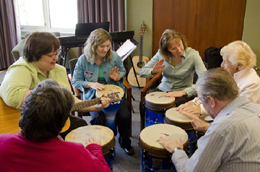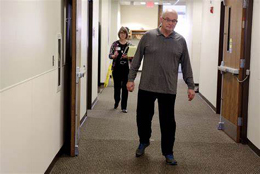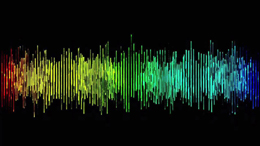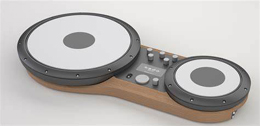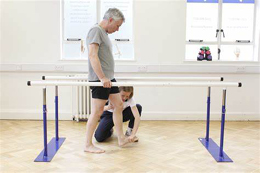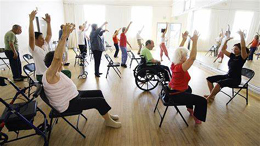Music therapy
Effects of Musical Cueing in Gait Kinematics
Abstract
Swinging of the arm is biologically rhythmic when paired with normal walking. Rhythmic Auditory Stimulation uses the physiological effects of auditory rhythm on the motor system to improve the movement control in rehabilitation of adaptive gait patterns in patients with significant gait deficit due to neurological impairment. Most people with Parkinson’s disease experience walking difficulties as the disease progresses and eventually have a profound impact on daily living activities with subsequent loss of independence. This rhythmic musical cueing technique is very effective in gait kinematics for patients with Parkinson Disease. Social dancing in a group is also very effective to improve balancing and emotional well-being with social support.
During our Thursday evening session, Mrs. Nilima, a 74-year-old lady diagnosed with early-stage PD came to our therapy centre for musical cueing exercises. After primary counselling and need-assessment, her lowest score areas were mobility, emotional well-being and social support. She is concerned regarding her walking pace, balance and ability to participate in some daily living activities. A three-day per week individual session of musical cueing is included in her treatment plan along with group dancing class.
To understand what is musical cueing we need to understand the two important components of gait kinematics:
i. Gait cycle
It is also called ‘Stride’ and can be measured in both time and distance. The cycle is the sequence that each limb goes through repetitively as we ambulate. There are two phases in the gait cycle, one is called stance phase in which the foot is on the ground and the other is swing-phase where it is in the air. The stride begins when the foot hits the ground to start the stance phase and ends after the stance and swing phase have been completed, when the same foot hits the ground again. During the gait cycle, when both feet are on the ground, it is called ‘double support time’. So with any abnormal gait pattern, there is usually an increase in the double support time with an effort by the body to improve stability and decrease the risk of falling.
ii. Step
A step is measured from the time when one foot hits the ground, until the time when the other hits the ground. We count steps when we calculate cadence or step per minute.
Nilima may subconsciously time her motor actions to an auditory rhythmic stimulus when she pays no attention to the music. Within music, the pitch and the rhythm combine to provide a melodic pattern whereas an electronic tabla app only provides a rhythm. When she dances to the music of Momo chitte Niti nritya, written by Rabindranath Tagore during a group dancing session, we as therapists can channelise her hands movements to some basic daily living exercises like how to hold handles or how to comb her hair. But on the other hand, to increase her walking stride length, we use Rhythmic Auditory Stimulation based on six beats of Taal - Dadra without music to do the six steps exercise of RAS. The attraction of making rhythmic movements to a rhythm is further exemplified by the finding that she is having more difficulty to tap in between the beats than on the beat. However, she may also have difficulty hearing the beat with music and therefore have problems synchronising her movements with it. So, listening to music may demand some additional attentional resources and, could potentially adversely affect her gait performance. But RAS, used in combination with gait training improves her walking velocity and step length. Overall, eight individual sessions of RAS with six beats parameter improves her gait with good stride length. Below, mentioned pointers for Nilima are a good example for overall benefits of a PD patient from the Rhythmic Auditory Stimulation.
1. Increasing stride length and taking bigger steps.
2. Emphasise the heel strike, and with a heel-to-toe gait pattern this will help to decrease toe walking
3. Improvement of posture and some balance training to reduce their fall risk.
4. ‘Stop and Go’ rhythmic cueing can be used to work on initiation and coordination.
5. Slowly progress the duration to increase functional endurance
6. To improve the ability to walk through doorways, keeping to the beat.
What Is RAS?
Therapeutic Mechanisms - Rhythmic Auditory Stimulation is based on four neurological principles, namely rhythmic entrainment, priming, cueing of the movement period and stepwise limit cycle entrainment.
Rhythmic entrainment is the ability of the motor system to couple with the auditory system and drive movement patterns. Central pattern generators are local spinal cord circuits that help to connect incoming sensory information to appropriate motor neurons that enable movement. The CPG are capable of producing coordinated movement of the limbs with no input from the brain. Therefore, this magnet effect of auditory rhythm in synchronising and entraining movement patterns occurs even at levels below conscious perception and without cognitive learning.
Priming is the ability of an external auditory cue to stimulate recruitment of motor neurons at the spinal cord level, thus resulting in entrainment of the muscle activation patterns in the legs during walking. The concept of cueing of the movement period depends on rhythmic entrainment and motor synchronisation mechanism. When rhythm is used in cuing with movement that means the time stability is enhanced by rhythmic synchronisation throughout the whole duration and trajectory of the movement, and not just at the endpoints of the movements. A limit cycle is the step cadence or frequency in which a person’s gait functions optimally.
What is RAS gait training?
This training consists of six steps and the amount of time dedicated by the therapist in each and every step depends upon the level of functioning of the client. RAS training session always begins with a thorough assessment of the client’s gait parameters. This assessment includes a ten metre walk to calculate current cadence (in steps/minute), velocity (in metres/minute) and stride length (in metres). Therapists should also evaluate gait kinematics, such as symmetry of gait, muscle weakness, trunk rotation, arm swing, posture, heel strike, toe off, single and double support time, and effective use of an assistive device. In addition to the above-mentioned assessments in gait kinematics and stride length, several standardised gait assessments, such as the ‘Timed up and Go Test’ can be used to collect additional information related to gait deviations.
In RAS gait training step 2 is all about adding a rhythmic cue through a metronome/electronic tabla and music with a strong 2/4 metre walk, depending upon the tempo which is having the same cadence during the client’s initial assessment. Metronome/electronic tabla does not need to be audible to the client, but it should be audible to the therapist to make sure that the rhythmic cue is always driving the movement and that the therapist who is not musically responding to fluctuation in the patient’s speed. Initially, the therapist may need to provide verbal cues to help the patient to entrain, but they should then fade their verbal cueing and allow the rhythmic auditory stimulus to drive the movement pattern. The therapist should observe any immediate effects that the rhythm may have on the gait kinematics, such as increased step-length, symmetry, or changes in single and double support time. In step 2, the therapist should include pre-gait exercises like a variety of movements, stepping forward and backward, trunk rotation and arm swing exercises with dowels, heel-to-toe rocking, long arc quads, and leg abduction/adduction.
In step 2, with the help of pre-gait exercises, the therapist is able to help the client to increase the cadence and start to normalise their gait pattern so that the client can walk faster. In step 3, the therapist begins to speed up the rhythmic auditory cue by 5-10% in order to see whether the patient can maintain the practised gait pattern as they work to bring the patient’s limit cycle to a more normal range. During steps 1-3 in RAS gait training under controlled conditions, therapists should address the most basic aspects of gait and mobility. In step 4 therapist creating exercises using RAS to practice those advanced gait situation that we encounter in everyday life, for example, walking on uneven surfaces, stopping and starting movement, walking around obstacles, walking up stairs, changing direction during walking, speeding up and slowing down, and walking with and without an assistive device. Some exercises are as follows:
1. walking to the beat of music that fluctuates in tempo
2. walking outside on different surfaces — grass, sidewalk, ramp
3. walking forward when the music starts and stopping when the music stops
4. walking backward to a rhythmic cue.
In step 5 of RAS gait training the therapist should gradually start fading the music and metronome/electronic tabla as the client is walking and finally take the rhythmic auditory stimulus away and observe whether the patient can maintain the changes in their gait pattern without the music. The therapist can provide the verbal cues if the client is not able or is slowly coping with the new pattern. Otherwise, they may need to bring the rhythmic cue in and out several times as the patient is walking.
In the 6th step of gait training, the therapist re-assesses the client with the same procedure as they did in step 1 to calculate the stride length now.
Supportive research
People with PD typically walk slowly with short shuffling steps, and often fall, due to a decreased balance, festination, and freezing of gait. Since walking is an essential for many activities of daily living, these problems can have a detrimental effect on independence and quality of life. Musical cueing provided by a metronome or electronic tabla can be described as a relatively simple technique for improving the gait of patients with PD. RAS can also include rhythmic cues embedded in music, which can additionally provide a cultural and motivational context.
Von Wilzenben, reported in the year 1942 for the first time on the facilitation of gait in patients of PD with sensory cues. In 1963, the detailed study and analysis of the effect of external cueing on gait was provided by Martine. After a few years, Dr. Trombly noticed that a patient who used to “freeze” while walking did not freeze while dancing. In the year 1987, Gauthier explained in his research that Auditory cues have been applied in the form of music as well as a metronome in combination with other physiotherapeutic techniques within a functional rehabilitation programme with a long term follow up. In 1996 the first systematic investigation of auditory rhythmic cues in gait training for PD was carried out by Thaut and Miller, who studied the effect of a 3-week daily home-based rhythmic training programme compared with self-paced gait exercise and no specific gait training. Pre and post tests were assessed without rhythmic training cues and eventually Thaut et al. introduced the term rhythmic auditory stimulation (RAS). Based on this evidence, the use of RAS provided as a rhythmic beat was recommended as a part of physical therapy intervention in guidelines to improve gait and gait related activities in rehabilitation of PD patients. In the year 2005, Lim et al. explained RAS as directed at influencing cadence, however it may indirectly affect other gait parameters such as stride-length and walking speed as well. So finally, we got the definition of RAS as, “Rhythmic auditory stimulation (RAS) is a neurological technique used to facilitate the rehabilitation, development and maintenance of movements that are intrinsically biologically rhythmical. This primarily refers to gait. However, armswing is also rhythmic when paired with walking. RAS uses the physiological effects of auditory rhythm on the motor system to improve the control of movement in rehabilitation of functional, stable, and adaptive gait patterns in patients with significant gait deficits due to neurological impairment. Research has shown RAS to be effective in two different ways: first as an immediate entrainment stimulus providing rhythmic cues during movement, and secondly, as a facilitating stimulus for training in order to achieve more functional gait patterns (1).”
In conclusion, the case study and supportive research data emphasises that gait and balance movement problems are very common in patients with Parkinson’s disease. The study shows that potential of musical cueing as a therapeutic strategy to improve mobility and gait kinematics is well recorded and opens the door for further research in rhythmic auditory stimulation techniques for better results in some other typical characteristics in PD Patients. Group dancing helps the patients to not only improve their balance and other gait kinematics but also helps in emotional well-being and social support.
Reference
1. Thaut, MH. and Hoemberg V. Handbook of Neurologic Music Therapy, Oxford: Oxford University Press; 2014, pp. 69-105.
Dr. Aradhana Deogharia is a neurological music therapist and the Founder and President of NAVYA Foundation, USA.
Share with us (Comments,contributions,opinions)
When reproducing this feature, please credit NAMAH,and give the byline. Please send us cuttings.

